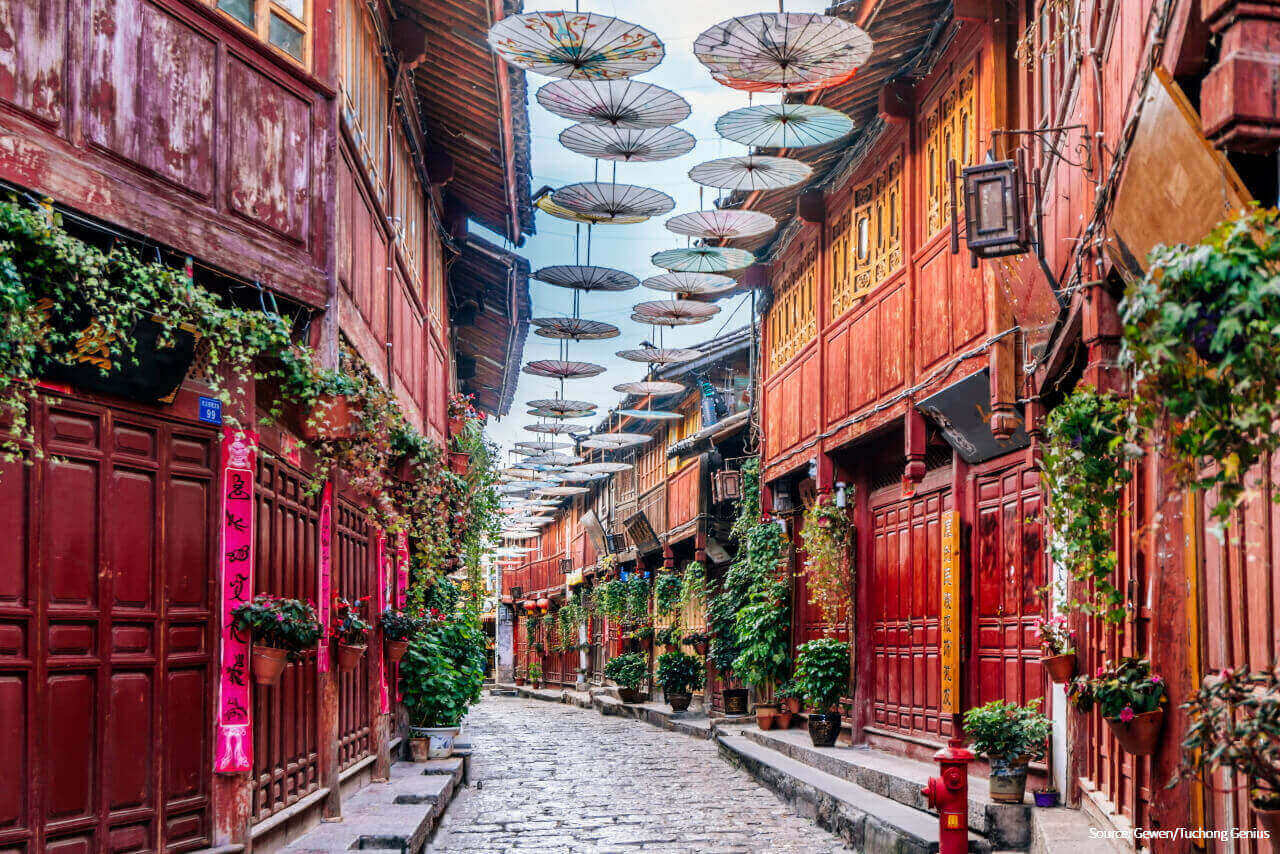
Lijiang Ancient Town
Name in Chinese: 丽江古城 Lì Jiāng Gǔ Chéng [li: dʒæŋ gu: tsen]
Duration of Tour: Half a Day
Location: No.1, Dongda Street, Gucheng District, Lijiang Prefecture, Yunnan Province
Highlights: the Ancient Chinese Architecture and the Na-chi People’s Traditional Culture
Must-see Sightseeing Spots: Mufu Palace, Wanfeng Pavilion and Sifang Street
Reputations: One of China’s Most Attractive Old Towns, a World Cultural Heritage Site, a Five-star Scenic Area
Lijiang Ancient Town is widely known as the Most Romantic Town in Mainland China. It is notable for its picturesque setting and the Na-chi people’s traditional culture. The town has a long history. It was founded in the late thirteenth century by the chieftain of the Mu clan. Since Joseph Rock recorded the town in his travel notes and published his works, Lijiang Ancient Town has become a popular destination for both domestic and foreign tourists. The town combines the features of ethnic minorities’ architecture, such as the Na-chi Group, Tibetan People, the Bai People and the Yi Nationality. The houses are built and decorated in the traditional way. Sometimes, the locals dance together to entertain themselves in the town square in the evening, wearing their own folk costumes. As one of the must-see attractions in Southwestern China, the old town was added to the list of world cultural heritage sites by UNESCO in 1997. It has been also designated as a national five-star scenic area.
The old town is also called Dayan Ancient Town by locals. It covers an area of 728 hectares(1,799 acres). There are many places of interests in or near the old town. Some of the famous sightseeing spots are Mufu Palace, Sifang Street, Wufeng Pavilion, etc. The nearby scenic areas include the Jade-Dragon Snow-capped Mountain, the Black-Dragon Pool, Shuhe Ancient Town, Baisha Village and the Golden Pagoda.
Mufu Palace
Mufu Palace can be traced back to the Yuan Dynasty(1271-1368). It used to be Chieftain Mu’s mansion. The Mu clan ruled their territory for over 400 years. The compound covers an area of 3 hectares(7.5 acres). It is quite a luxury mansion.
Wufeng Pavilion
Wufeng Pavilion is situated in Fuguo Monastery. It was originally constructed in the year of 1601. The name of the pavilion, “Wu-Feng” means “five phoenixes”. The building is 20 meters(66 feet) in height. It is a typical example of architecture which combines the Han’s style with Tibetan style and the Na-chi’s.
Sifang Street
Sifang Street is at the center of the old town. Most of the shops in the street sell a variety of local snacks.
Travel Tips:
How to Get to Lijiang Ancient Town
Lijiang Ancient Town is located about 500 kilometers(311 miles) to the northwest of Kunming, the capital city of Yunnan Province. Some of the tourist fly to Lijiang from major cities in Mainland China, such as Beijing, Chengdu and Shanghai. Some others travel to Lijiang from Kunming by car or bullet train.
How to Avoid Altitude Sickness
The old town is at an elevation of 2,410 meters(7,907 feet). But some nearby scenic areas are higher than 3,000 meters(9,843 feet) above sea level. The tourists might suffer from the Acute Mountain Sickness(AMS). Tips for you to prevent the AMS include keeping hydrated, avoiding a cold, acclimatizing to altitude gradually, avoiding rapid ascent and strenuous exercise, restraining from smoking and drinking alcohol.
Weather
The tropical latitude of Lijiang means that you need to bring some suncream and sunhats when you travel to Lijiang. Both spring and autumn are the best time to visit Lijiang. The spring comes in February and goes in April, while the autumn lasts from September to November. You also need to pack some winter clothes for your tour to Lijiang, even in summer.
Suggested Itineraries:
Related Articles:
Author: Tina Luo
Update:

Lijiang Ancient Town